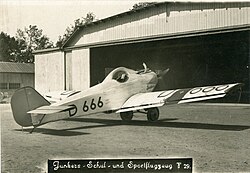Junkers T 29
| Junkers T 29 | |
|---|---|

|
|
| Type: | Training aircraft , sport aircraft |
| Design country: | |
| Manufacturer: | |
| First flight: |
1925 |
| Number of pieces: |
2 |
The Junkers T 29 was a single-engine, low- wing training and sports aircraft made by the German manufacturer Junkers in 1925 . Since no buyers were found, only two aircraft were built and used by Junkers as test aircraft.
construction
The T 29 was an all-metal aircraft with corrugated iron planking. A 59 kW Junkers L-1 engine was used in it.
A special feature for a sports machine of the time was the adjacent seats in the open cockpit. This should improve its use as a training aircraft. A kind of roll bar was located above the cockpit, which protected the occupants in the event of a rollover. This gave the aircraft the nickname "iron".
The use of the so-called Junkers double wing according to DRP no. 396621 (German Reich patent) dated June 12, 1921 , as they were later used on the Junkers G 38 and Junkers Ju 52 / 1m .
Technical specifications
| Parameter | Data |
|---|---|
| crew | 1 |
| Passengers | 1 |
| length | 7.15 m |
| span | 11.50 m |
| height | 2.25 m |
| Wing area | 15.60 m² |
| Empty mass | 490 kg |
| Payload | 200 kg |
| Takeoff mass | 690 kg |
| Wing loading | 48.00 kg / kW |
| Power load | 10.00 kg / m² |
| Engines | an air-cooled six-cylinder in - line engine Junkers L1a with 59 kW (80 PS) |
| Top speed | 140 km / h |
| Cruising speed | 120 km / h |
| Summit height | 2500 m |
See also
literature
Günter Schmitt: Junkers and his planes . 2nd unchanged edition. Transpress, Berlin 1986, ISBN 3-344-00192-2 , p. 108 .
Web links
Individual evidence
- ↑ Bernd Junkers: April 22, 1925: The flying "iron" is approved. In: Hugo Junkers: A life for technology. JUMA Verwaltungsges.mbH, accessed on August 4, 2015 .
